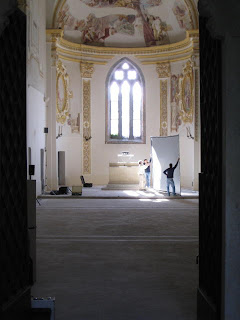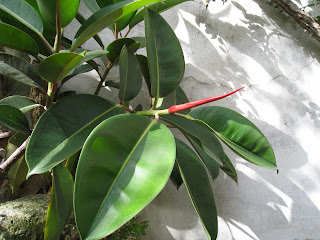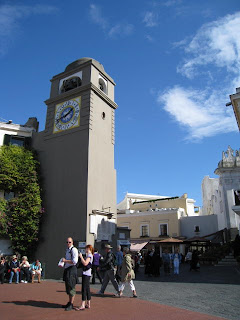
A chronicle of a part-time life in a small town near Lucca, Italy with occasional posts about life on Whidbey Island and other travels...
Friday, October 30, 2009
Capri's Lushness
One of the things I really enjoyed about Capri was it's lushness. Even in mid October there were still many flowers in bloom including roses. There were also interesting plants such as giant cactus and unusual evergreen trees. Here are a few photos of some of the plants we saw.


Labels:
Life in Italy,
Trip to Capri October 2009
Terzo Giorno a Capri
Our third day on Capri was actually spent off Capri. We got going early and caught a boat into Naples to visit the Museo Archeologico where many of the Pompeii mosaics, frescoes and artifacts are located.

On our way from the ferry dock to the museum we saw a demonstration taking place. It was fairly quiet and, as is usual in Italy, there were lots of police on the street.

This statue of Dante Alighieri (author of The Divine Comedy) is the largest I have ever seen. They are not uncommon throughout Italy as Dante is considered the father of the Italian language. However, this one was even bigger than Michelangelo's David. It was located in an equally large piazza in front of Naples' Galleria.

This is looking into Naples' Galleria, an early shopping mall. Unfortunately, it looked like many of the shops are closed and it had a rather abandoned air.

The part of Naples we saw looked a lot like this. There were wide boulevards and many grand buildings that looked vaguely French.

At the museum we saw an incredible array of artifacts from throughout Italy. I did not take many pictures but I really liked this pottery.

This is one of the most famous mosaics from Pompeii. The individual pieces are very small--perhaps a square centimeter each. It has to have been incredibly skilled work to have created this sort of mosaic work.
It was well worth the effort to visit the museum. I have been to Pompeii twice and it is an incredibly place as well. It can be frustrating when touring the excavated city because there are plaques everywhere saying the original mosaic or fresco is located at the archeological museum. Sometimes pictures of the originals are there but often one is just left with the feeling of having missed something.

After the museum we found a pizzeria and had lunch. Then we walked over to the Duomo--the church of San Gennaro. Unfortunately it was closed until 5 pm.

On the way home it started to rain. Fortunately, it quit by the time we got to Capri so our journey back to the hotel was dry.
The following day we reversed our original journey. We went from Anacapri by bus to Marina Grande, from to Marina Grande to Naples by foot ferry, from there to the train station by taxi, from Naples Centrale to Florence by Eurostar train, from Florence to Diecimo by two more trains. Our friend Anna picked us up at Diecimo and brought us to Partigliano.
It was a fun and interesting trip.

On our way from the ferry dock to the museum we saw a demonstration taking place. It was fairly quiet and, as is usual in Italy, there were lots of police on the street.

This statue of Dante Alighieri (author of The Divine Comedy) is the largest I have ever seen. They are not uncommon throughout Italy as Dante is considered the father of the Italian language. However, this one was even bigger than Michelangelo's David. It was located in an equally large piazza in front of Naples' Galleria.

This is looking into Naples' Galleria, an early shopping mall. Unfortunately, it looked like many of the shops are closed and it had a rather abandoned air.

The part of Naples we saw looked a lot like this. There were wide boulevards and many grand buildings that looked vaguely French.

At the museum we saw an incredible array of artifacts from throughout Italy. I did not take many pictures but I really liked this pottery.

This is one of the most famous mosaics from Pompeii. The individual pieces are very small--perhaps a square centimeter each. It has to have been incredibly skilled work to have created this sort of mosaic work.
It was well worth the effort to visit the museum. I have been to Pompeii twice and it is an incredibly place as well. It can be frustrating when touring the excavated city because there are plaques everywhere saying the original mosaic or fresco is located at the archeological museum. Sometimes pictures of the originals are there but often one is just left with the feeling of having missed something.

After the museum we found a pizzeria and had lunch. Then we walked over to the Duomo--the church of San Gennaro. Unfortunately it was closed until 5 pm.

On the way home it started to rain. Fortunately, it quit by the time we got to Capri so our journey back to the hotel was dry.
The following day we reversed our original journey. We went from Anacapri by bus to Marina Grande, from to Marina Grande to Naples by foot ferry, from there to the train station by taxi, from Naples Centrale to Florence by Eurostar train, from Florence to Diecimo by two more trains. Our friend Anna picked us up at Diecimo and brought us to Partigliano.
It was a fun and interesting trip.
Labels:
Life in Italy,
Naples,
Pompeii,
Trip to Capri October 2009
Monday, October 26, 2009
Maiolica on Capri
At the south end of the Amalfi Coast, near Capri, is the town of Vietri sul Mar. It is a major center for the production of Italian maiolica. Everywhere on Capri one sees maiolica tiles. I took most of these photos in Anacapri as we walked back to our hotel on our second day on Capri.

The benches in front of the church of Santa Sofia are made of maiolica tiles with elaborate scenes painted on them.

This is a close-up of one of the scenes--a depiction of the traditional vendemia (grape harvest).

A restaurant sign.

The benches in front of the church of Santa Sofia are made of maiolica tiles with elaborate scenes painted on them.

This is a close-up of one of the scenes--a depiction of the traditional vendemia (grape harvest).

A restaurant sign.
House name and number.
The local St. Vincent De Paul society.
Secondo Giorno a Capri - Seconda Parte
After we left the belvedere at Certosa di San Giacomo we walked over to the Giardino di Augusto. From what I had read I expected an elegant garden but it the giardino turned out to be a city park. It was nice but awfully crowded.

The views from the giardino were spectacular. We could look back into the cloister at the monastary.

To the south we could see the faraglioni--two of the large rocks that emerge from the sea around Capri.

This lovely statue was the centerpiece of part of the gardens. It was a quiet spot away from the magnificent views. The landscaping was actually quite nice but it seemed secondary to the views.

From the garden we discovered the path built into the side of the cliffs that links Capri town and Marina Piccola. From the plaque we read it seems it was impossible to get directly from one to the other until the early years of the 20th century when this path was finished.

We decided to walk down the switchback path and find lunch at Marina Piccola. Our decision was made after we were assured there was a bus we could take back up from Marina Piccola.

Many of the buildings on Capri have a distinctly Greek look to them. Often the roofs are barrel shaped as can be seen on this building in Marina Piccola.

When we got down to Marina Piccola we found a bar at the bus turnaround and ate panini in the sunshine. Afterwards we walked down to the water's edge. It was rocky in spots but there was also a fairly large sandy beach. It turned out there were two or three bars right there with decks over the water.

There were actually quite a few people in the water swimming. The next time I am on Capri I want to eat down here and dip my toes in the water.

After lunch we took the bus back to Capri town where we transfered to a bus for Anacapri. When we got back to the hotel we went out on the upstairs terrace and looked for the sheep we thought we had heard our first night there as we arrived. In the field next to the hotel we discovered two large sheep taking their ease in the shade. They had a stone hut in which to get out of the weather and lots of green grass. This is a great example of the classic Italian mix of town and country. It is often hard to tell where one ends and the other begins.

The views from the giardino were spectacular. We could look back into the cloister at the monastary.

To the south we could see the faraglioni--two of the large rocks that emerge from the sea around Capri.

This lovely statue was the centerpiece of part of the gardens. It was a quiet spot away from the magnificent views. The landscaping was actually quite nice but it seemed secondary to the views.

From the garden we discovered the path built into the side of the cliffs that links Capri town and Marina Piccola. From the plaque we read it seems it was impossible to get directly from one to the other until the early years of the 20th century when this path was finished.

We decided to walk down the switchback path and find lunch at Marina Piccola. Our decision was made after we were assured there was a bus we could take back up from Marina Piccola.

Many of the buildings on Capri have a distinctly Greek look to them. Often the roofs are barrel shaped as can be seen on this building in Marina Piccola.

When we got down to Marina Piccola we found a bar at the bus turnaround and ate panini in the sunshine. Afterwards we walked down to the water's edge. It was rocky in spots but there was also a fairly large sandy beach. It turned out there were two or three bars right there with decks over the water.

There were actually quite a few people in the water swimming. The next time I am on Capri I want to eat down here and dip my toes in the water.

After lunch we took the bus back to Capri town where we transfered to a bus for Anacapri. When we got back to the hotel we went out on the upstairs terrace and looked for the sheep we thought we had heard our first night there as we arrived. In the field next to the hotel we discovered two large sheep taking their ease in the shade. They had a stone hut in which to get out of the weather and lots of green grass. This is a great example of the classic Italian mix of town and country. It is often hard to tell where one ends and the other begins.
Sunday, October 25, 2009
Secondo Giorno a Capri - Prima Parte
Our second day on Capri dawned clear and cold. We bundled up after breakfast and walked into Anacapri to catch the bus to the town of Capri.
In the piazzetta in Anacapri there were always a number of taxis waiting. The standard Capri taxi seats six or seven and is a convertable. I don't think I saw one with the top down while we were there but I could just imagine the tourists zipping around the island in the summer with the wind blowing in their hair.
On an island where one of the main forms of transportation are scooters and motorcycles, this is what one of the parking lots near the town center looks like.
This clock tower is in the center of Capri with the main piazza just beyond it. There were lots of tourists and shop windows to look at so I forgot to take many more pictures.

I do not find the shoes in Italy very appealing this fall. Here is a pair of Dolce e Gabbana pumps that seem particularly ugly. Patent leather seems to be all the rage but 95% of the shoes are black. Shop windows are supposed to label everything with the price but this law is often ignored. The pricier the store the more likely there are not prices displayed. However, I am willing to bet these shoes cost more than I am willing to pay.

From the center of town we walked down to the Certosa di San Giacomo (St. James' Cloister). You can see the top of the bell tower and part of the old monastary complex beyond the gardens.

The church was closed to visitors but the doors were open. We could see inside to the newly restored frescoes. It looked like they were setting up for a photo shoot.
Inside part of the old monastary is an exhibit of paintings by a German artist who lived on the island for many years around 1900. The pictures were huge and not terribly appealing. No photos were allowed so you will have to go check them out for yourself.

As we entered the monastary this cat walked up and asked to be petted. After we obliged it followed us around as we explored.

The interior of the monastary was generally plain but it has some interesting features. This heavy wooden door has a beautiful stone surround.

Part of the monastary is now used as a high school. While we were there the students took a break and gathered in the old cloister to relax.

I took this photo of the clouds moving in through one of the arched openings leading to the cloister.

We followed the path through the trees and shrubbery and found this beautiful "belvedere" overlooking the water. There are many of these spots on Capri. The last time we were on the island we visited one that was about twice as high up. I could not stand to get near the railing there but this one was not as bad.

From the belvedere we could look across the west side of the island. The rugged topography of Capri is apparent from here. There are only a handful of places along the shore where it is possible to land a boat. That helps explain why it has been settled since ancient times. It would have been easily defensible. Nonetheless, it was attacked time and again including by the pirate Barbarossa.

There was a stone bench at the belvedere and it was protected from the chilly breeze so we lingered there for a while. The friendly cat had followed us out to the edge and wanted more petting. It hopped up next to Dom and he obliged while I took a picture.

When I sat down the cat crawled right up on my lap. It was nice to get a good kitty fix. None of our Partigliano cats will sit on my lab.
Labels:
Cats,
Life in Italy,
Trip to Capri October 2009
Subscribe to:
Comments (Atom)























